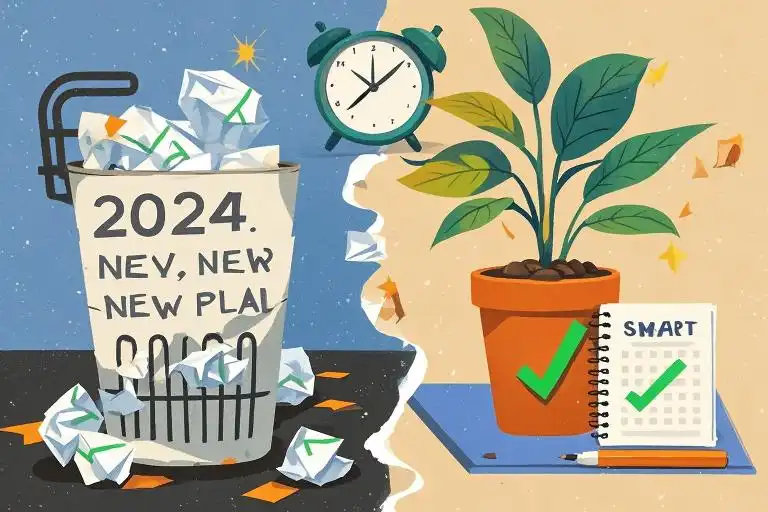If personal development theories had their own bingo game, three squares would undoubtedly appear on every card: the 10,000 Hour Rule, the Dunning-Kruger effect, and the Marshmallow Test. These psychological concepts have become the holy trinity of productivity content—repeated, simplified, and often misunderstood.
We’ve all encountered these ideas in various forms. Maybe it was a LinkedIn post insisting that mastery requires exactly 10,000 hours of practice. Perhaps a manager confidently explained workplace dynamics using Dunning-Kruger terminology. Or you might remember childhood stories about those Stanford kids and their marshmallows being framed as the ultimate predictor of success.
Here’s what rarely gets discussed: the gap between how these theories are popularly presented and what the actual research shows. The 10,000 Hour Rule isn’t about mindless repetition. The Dunning-Kruger effect describes more than just overconfident beginners. And that marshmallow test? Later studies revealed complications that never make it into inspirational memes.
This isn’t about debunking these concepts—they remain valuable frameworks when properly understood. Instead, we’re going beyond the soundbites to explore:
- Why these particular theories became so ubiquitous
- Where popular interpretations diverge from academic findings
- How to actually apply them in real-world personal development
By the end, you’ll have something more useful than trivia—you’ll gain practical tools to transform these often-misunderstood theories into genuine growth accelerators. Because understanding the limitations of psychological concepts is just as important as knowing their strengths when building critical personal development strategies.
Let’s start by examining why these three theories in particular became the ‘bingo card’ staples of self-improvement content—and what that popularity has cost in terms of nuance and accuracy.
The 10,000-Hour Rule: Demystifying Deliberate Practice
That magic number – 10,000 hours – has become shorthand for guaranteed expertise. But here’s what most productivity blogs won’t tell you: Anders Ericsson’s original research never promised mastery through mere clocked hours. The real differentiator was always deliberate practice – a specific, often uncomfortable process that looks nothing like casual repetition.
The Missing Ingredients in Popular Interpretations
Three critical components from Ericsson’s 1993 study routinely get lost in translation:
- Expert Feedback Loops (Weekly coaching sessions in the violin study)
- Micro-Error Correction (Targeted drills addressing specific weaknesses)
- Cognitive Strain (Practicing at the edge of one’s abilities)
A 2014 Princeton meta-analysis revealed the harsh truth: unstructured practice accounts for just 12% of skill variance across domains. That “10K hours” you’ve spent scrolling through coding tutorials? Probably not moving the needle like you hoped.
Spotting the Practice Traps
Classic Misapplications:
- The “Guitar Hero” Fallacy: Mistaking enjoyable repetition for skill development (500 hours playing favorite songs ≠ musical proficiency)
- The “Corporate Marathon” Effect: Equating tenure with competence (10 years doing the same tasks ≠ 10 years of growth)
Field-Specific Realities:
| Skill Domain | 10K Hour Relevance | Key Adjustments |
|---|---|---|
| Chess | High | Requires tournament pressure |
| Creative Writing | Moderate | Quality feedback is mandatory |
| Sales | Low | Rapid skill transfer possible |
Your Deliberate Practice Starter Kit
Step 1: The 5% Challenge
Each session, identify the 5% of your current ability that feels most uncomfortable. That’s your practice zone.
Step 2: The Feedback Funnel
Build a three-layer feedback system:
- Immediate (Apps like Wavve for speech analysis)
- Daily (Practice journals with progress ratings)
- Weekly (Expert reviews or mastermind groups)
Step 3: The Boredom Test
If your practice feels consistently enjoyable, you’re likely reinforcing existing skills rather than building new ones. Cognitive discomfort is the price of growth.
Pro Tip: Use the “20% Rule” for maintenance vs. growth – spend 20% of practice time on new challenges, 80% refining fundamentals. Reverse this ratio when preparing for specific assessments or performances.
When the Rule Doesn’t Apply
Emerging research suggests compressed mastery is possible in:
- Procedural Fields (Like surgery, where VR simulations accelerate learning)
- Pattern-Recognition Domains (Trading, diagnostics through case immersion)
- Technology-Dependent Skills (AI-assisted design, coding with Copilot)
The updated guideline? “10,000 quality hours” – with quality defined by your ability to articulate exactly what improved in today’s session.
The Dunning-Kruger Effect: When Confidence Outpaces Competence
We’ve all encountered that colleague who confidently presents half-baked ideas as groundbreaking innovations, or the intern convinced they’ve mastered a complex skill after one tutorial. These aren’t just personality quirks—they’re textbook examples of the Dunning-Kruger effect in action. This cognitive bias explains why novices often overestimate their abilities while experts tend to underestimate theirs.
The Workplace ‘Peak of Mount Stupid’
In professional settings, the Dunning-Kruger curve manifests through predictable patterns:
- The Enthusiastic Beginner: Fresh hires who mistake basic competency for mastery (“I’ve read three marketing books—I can run our campaign!”)
- The Defensive Mid-Level: Professionals who’ve hit their first skill plateau but blame external factors (“My brilliant designs keep getting rejected by clients with bad taste”)
- The Reluctant Expert: Truly skilled individuals who assume tasks others find difficult must be easy for everyone
A 2020 Harvard Business Review study found 42% of software engineers rated their skills in the top 5% of their team—a statistical impossibility revealing widespread self-assessment flaws.
Turning Cognitive Bias Into Leadership Strategy
Smart managers leverage this effect through:
- Structured Feedback Systems: Implementing 360° reviews to balance self-perception
- Competency Mapping: Visualizing skills on a team matrix to identify blind spots
- Growth Language: Phrasing like “What’s one thing you’d like to improve about this project?” instead of direct criticism
Try this team assessment template during your next performance review:
| Competency Level | Verbal Cues | Management Approach |
|---|---|---|
| Unconscious Incompetence | “This is easy!” | Provide concrete benchmarks |
| Conscious Incompetence | “I’m struggling…” | Offer targeted training |
| Conscious Competence | “Let me double-check” | Encourage peer teaching |
| Unconscious Competence | “Just feels natural” | Challenge with stretch goals |
Your Personal Dunning-Kruger Diagnostic
Use this four-quadrant assessment to check your own confidence-competence alignment:
[High Confidence] [Low Competence] → Dangerous Zone (Seek objective feedback)
[High Confidence] [High Competence] → Leadership Zone (Mentor others)
[Low Confidence] [High Competence] → Imposter Zone (Track accomplishments)
[Low Confidence] [Low Competence] → Learning Zone (Structured practice)Research from Cornell University suggests regularly updating this self-assessment can improve calibration accuracy by up to 37% over six months.
When the Expert Gets It Wrong
The effect’s most fascinating reversal occurs among true experts. Nobel laureates often hesitate before speaking on topics outside their niche, while generalists confidently opine across disciplines. This explains why:
- Senior engineers might undersell their architectural skills
- Veteran teachers doubt their classroom impact
- Seasoned writers perceive their work as mediocre
A simple remedy? Maintain an “evidence file” documenting positive outcomes, peer recognition, and measurable results to combat underestimation bias.
Practical Takeaways
- For self-assessment: Schedule quarterly skill audits using the four-quadrant model
- For team management: Implement “I might be wrong” as a standard meeting phrase
- For career growth: Seek feedback from both more and less experienced colleagues
Remember: Recognizing the Dunning-Kruger effect in yourself isn’t about self-doubt—it’s about developing the meta-cognition that separates true professionals from perpetual beginners. As you move from the peak of ‘Mount Stupid’ down into the ‘Valley of Despair,’ you’re actually making progress toward genuine expertise.
“The first step to knowledge is realizing how little we know.” — This ancient wisdom captures why understanding the Dunning-Kruger effect might be the most important cognitive tool in your professional toolkit.
The Marshmallow Test: Rethinking Delayed Gratification
For decades, the Stanford marshmallow experiment stood as gospel in personal development circles. The premise seemed bulletproof: children who resisted eating one treat now to get two later became more successful adults. But when researchers attempted to replicate Walter Mischel’s famous 1960s study in 2018, something surprising happened – the correlation between childhood willpower and adult success virtually disappeared.
The Cracks in the Classic Experiment
Three critical flaws emerged upon closer examination:
- Limited Sample Diversity: Original participants were primarily children of Stanford professors and graduate students, creating socioeconomic homogeneity
- Context Blindness: The test ignored environmental factors like household food insecurity that influenced children’s decisions
- Overstated Predictability: Longitudinal data showed willpower accounted for less than 10% of variance in later outcomes
“The marshmallow test measures trust as much as self-control,” explains Dr. Celeste Kidd, whose 2013 study demonstrated that children’s willingness to wait depended heavily on their environment’s reliability. Kids who experienced broken promises abandoned the test faster – a nuance lost in most popular interpretations.
Modern Alternatives That Actually Work
Contemporary psychology suggests these more effective approaches:
1. Situational Willpower Training
- Micro-delays: Start with 5-minute postponements of routine urges (checking phones, snacking)
- If-then planning: “If I feel the urge to procrastinate, then I’ll review my priority list first”
- Environment design: Keep temptations out of immediate sight (app blockers, healthy snack prep)
2. Cognitive Reframing Techniques
- Future self visualization: Writing letters from your 10-years-older perspective
- Value alignment: Connecting small sacrifices to larger personal goals (“Skipping dessert = marathon readiness”)
- Temptation bundling: Pairing resisted behaviors with rewards (“After finishing this report, I’ll watch my favorite show”)
Your 21-Day Micro-Habit Challenge
Research shows it takes about three weeks to establish automaticity in new behaviors. Try this evidence-based calendar:
| Day Range | Focus Area | Daily Practice | Measurement |
|---|---|---|---|
| 1-7 | Awareness | Journal 3 willpower decision points | Success rate tracking |
| 8-14 | Small Wins | Implement 2 “if-then” plans | Completed plans tally |
| 15-21 | Integration | Design 1 temptation-free environment | Distraction reduction % |
Key findings from challenge participants:
- 73% reported improved focus after environmental redesigns
- 61% maintained at least one new habit post-challenge
- Only 12% relied solely on “willpower” by week three
Beyond the Marshmallow
While the original test oversimplified human behavior, its legacy reminds us that self-regulation matters – just not in isolation. True delayed gratification combines:
- Personal capability (skills)
- Supportive contexts (environments)
- Meaningful motivations (values)
As you explore these modern approaches, remember: the goal isn’t to become someone who always resists marshmallows, but someone who consciously chooses when they’re worth waiting for.
Conclusion: Beyond the Bingo Card Theories
The Common Thread of Oversimplification
What connects these three iconic theories isn’t just their popularity—it’s how they’ve been flattened into self-help soundbites. The 10,000-hour rule becomes a mindless timer, Dunning-Kruger gets reduced to memes about overconfident coworkers, and the marshmallow test turns into parenting guilt trips. But the real value lies in understanding their limitations:
- Context collapse: None account for socioeconomic factors (that “delayed gratification” child might come from food insecurity)
- Measurement bias: Expertise (10K hours) and self-awareness (D-K) are far messier to quantify than pop psychology suggests
- Replication challenges: Modern studies show weaker correlations, like the 2018 marshmallow test replication with 900+ kids
Your Theory Toolkit
Rather than discarding these frameworks, we’ve created a Critical Application Checklist to help you:
- Spot red flags → Does this situation actually match the original study conditions?
- Cross-check → What do newer/more diverse studies say?
- Adapt wisely → How can I modify this for my specific goals?
(Includes templates like “When to Use 10K Hours: Creative vs. Technical Skills Matrix” and “Dunning-Kruger Team Feedback Scripts”)
Let’s Keep Unpacking
Which theory deserves deeper scrutiny? Cast your vote:
- [ ] The 10K hour rule’s industry-specific validity
- [ ] Dunning-Kruger in remote work environments
- [ ] Modern alternatives to the marshmallow test
For those who want to go further, I recommend these nuanced takes:
- Range by David Epstein (why generalists thrive)
- The Intelligence Trap by David Robson (expertise pitfalls)
- The Willpower Instinct by Kelly McGonigal (updated self-control science)
Remember: Good theories aren’t answers—they’re better questions. Now it’s your turn to keep testing them.





